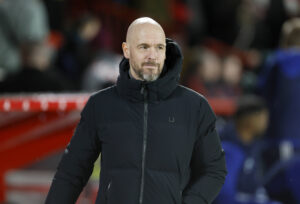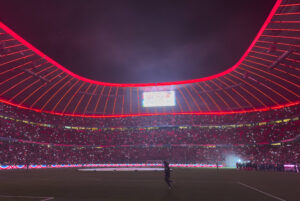It is entirely fitting that at this time of year, when so much is made of jettisoning the old and introducing the new, that Arsenal have already effected that change by replacing Mesut Özil with Lucas Torreira as the public face or image of the team. Of course, for all the rumours that his agent has been in Milan negotiating a transfer with former Arsenal chief executive Ivan Gazidis, Özil has not yet left Arsenal. However, there can be no doubt that he has been replaced both at the heart of the team and in the affection of the fans by the diminutive Uruguayan.
Lucas Torreira Has Already Replaced Mesut Özil As Arsenal’s Poster Boy
Arsenal’s final Europa League group match against Qarabag must have been hugely uncomfortable for Özil and not just because of the freezing temperatures. What must have been even more difficult for the German playmaker to take was the fact that he was playing in that game at all, given that the rest of the Arsenal eleven were either promising youngsters being given a rare run-out (such as Eddie Nketiah), squad players maintaining their fitness ahead of the intensely busy Christmas period (such as Mohamed Elneny) or players returning from long absences caused by injury (namely Laurent Koscielny). The very fact that Özil was playing at all in such an essentially meaningless game (Arsenal had not only already qualified for the final 32 but won the group, meaning that in the last 32 they will not play any of the third-placed Champions League teams dropping down to the Europa League) was the clearest indication yet that he is no longer central to Unai Emery’s plans for Arsenal.
By complete contrast, Lucas Torreira has already proved how completely central he is to Emery’s vision of a new Arsenal, and not simply because he plays in central midfield. After being slowly introduced to the team after his World Cup exertions for Uruguay in the summer (a move by Emery that looks increasingly shrewd given the dangers of World Cup burnout, especially in the unforgiving English top flight), Torreira has quickly established himself as the proverbial first name on the team sheet with a succession of superb performances, particularly in his last three games.
A Central Figure
Torreira was at the heart of everything good about Arsenal in their three games in a week against Spurs, Manchester United and Huddersfield. Before those games, he had already proved conclusively that he was precisely the kind of hard-running and even-harder-tackling defensive midfielder that the club had been crying out for since the days of Patrick Vieira and Gilberto Silva more than a decade ago. However, he then showed that he was not simply a defensive midfielder but an all-round midfielder, one who can also attack and, crucially, score goals.
Torreira scored his first goal for Arsenal against Spurs, which set the seal on the Gunners’ 4-2 defeat of their north London rivals, with an emphatic finish past Hugo Lloris. However, his second goal for the club, against Huddersfield the following weekend, was even more impressive, and not just because it was a superb overhead kick. (Some Arsenal fans have already contemplated placing bets on Torreira to score a number of overhead kicks this season, as his small frame necessitates such spectacular efforts instead of regulation headers.) In a game that Arsenal began sluggishly (which has become something of a theme under Emery) and then failed to improve greatly in the second half (which has certainly not been the case in most games under Emery), it was the little Uruguayan who literally led the team to victory by scoring the all-important goal with less than ten minutes of the game left.
Consequently, Torreira has already displayed many of the qualities that Özil, for all his undoubted ability (especially passing ability), lacks. First, he showed that he does not exclusively concentrate on either attack or defence, unlike Özil, whose defensive attributes are virtually non-existent. Secondly, he proved that he can play well against even the best sides in England (Manchester United may no longer be in that category but Spurs certainly are); and finally, and most importantly, he provided a reminder of the enduring truth of the old George Graham adage that the secret of success in football is good players working hard.
Dropping Down the Pecking Order
It is in the work stakes in particular that Özil compares so unfavourably with Torreira. Of course, they are different players playing in different positions, but regardless of a player’s precise position in a team he should be maximising his effort. With Torreira, that is thrillingly, visibly evident, but Özil, for all the sublime tricks and flicks he paraded against Leicester (champions two seasons ago but no longer a member of the English elite), is yet to get anywhere near the same level of play in a match against another top-six side, especially away from home.
For all the abuse (racial or otherwise) of Raheem Sterling by Chelsea fans last weekend, the key ‘C’ word in football remains ‘consistency’ and it is in that respect that Özil is found so desperately wanting in comparison with Torreira. Torreira has only been at Arsenal for a few months, compared to Özil’s five years, and yet he has already imprinted himself on the team in a way that Özil has simply never achieved. With Torreira, the suspicion is that he will always be an 8/10 performer and occasionally (as against Spurs) a 9 or even 10/10 performer, whereas with Özil there is a far steeper falling-off of performance. For all his brilliance against Leicester (and he was truly brilliant that night), he was almost non-existent against Crystal Palace less than a week later and ended up being substituted. Since then, he has not been a regular in the side.
In effect, Özil is the face of the old, late-Wenger era Arsenal, when technique (especially first touch) was prized so highly that virtually no other footballing qualities (such as physical prowess, team shape and, especially, defensive organisation) were given any thought at all. Torreira is the face of the new, all-action, all-pressing Emery Arsenal, in which technique is still highly valued but not at the expense of all other important footballing qualities.
Fight or Flight
The challenge now for Özil is to adapt or… well, if not die, then certainly be moved on. In everything that he has done at Arsenal so far, especially after the early losses against Manchester City and Chelsea were followed by the 22-game unbeaten run that is still continuing, Emery has proved that he learned a lot at Paris Saint-Germain, even if his time in charge there was brief. In particular, what appeared to be his complete inability to control Neymar and convert him into a true team player, because of the Brazilian’s perceived importance to the club after his transfer from Barcelona, has given way to an absolute determination not to make the same mistake again.
Emery is obviously determined to build a team in his own image: high-energy, high-pressing and high-performance. Torreira fits perfectly with that image, such that he is almost Emery’s personal representative, or even alter-ego, in the Arsenal side. By contrast, Özil increasingly looks like the embodiment of all the indolent, self-indulgent excesses and excuses that ultimately did for Wenger. If he is not to follow the Frenchman out of the door at Arsenal, he must change the habits of a lifetime and start adding some much-needed sweat to all that obvious technical ability.
Main Photo






